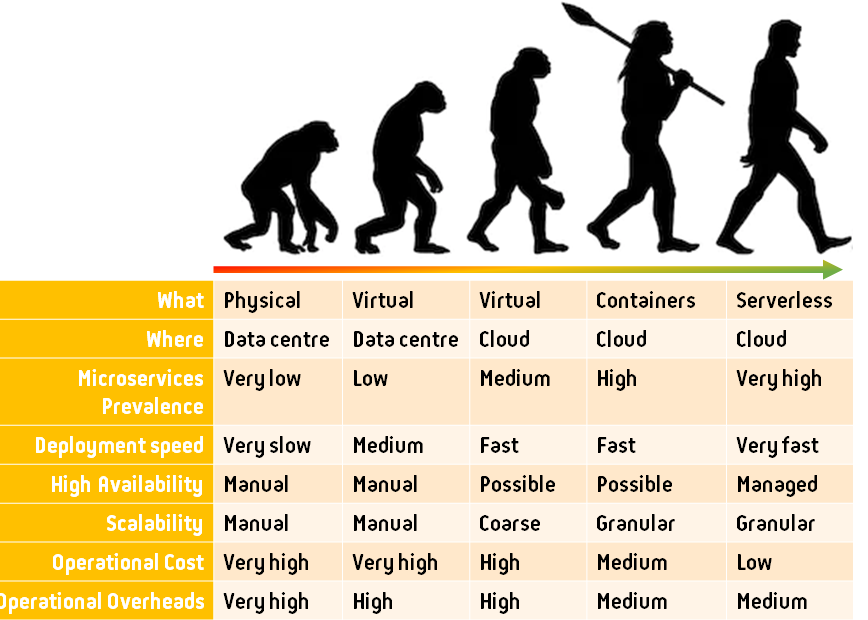Unless you’ve been under a rock, you’ve seen the impact that Hyperscale Public Cloud has made on the IT industry. Its invention wasn’t to be a thing, but to be a continually evolving, improving thing.
And while many organisations will use SaaS platforms, those platforms themselves often run atop the IaaS and PaaS platforms of a hyperscale cloud platform.
One person’s SaaS is another person’s IaaS.
Me, James Bromberger
But its worth just checking on the evolution of IT service delivery at a low level, for not everyone who is in the IT industry has seen what that looks like at this time.

Change is hard. Humans are bad at it. I’ve seen many who evolved from column 1 to column 2, and have felt they are “done”. They aren’t on-board for the next wave of the evolution.
I suffer from this too. But three is a short cut that I can offer: try to jump from where you are now, to as far to the right as you can in one step.
Every one of these phases is a monumental shift in the way that services are delivered, requiring training, and experience. There is an overhead knowledge baggage that engineers take with them, trying to work out what functions the same as before, and what is different. This is taxing, stressful, and unpleasant.
So rather than repeat this process in sequence, over years for each change, my recommendation is to see how far to the right you can jump. Some limitations will crop up that prevent you from leap-frogging all the way to Serverless, but that’s OK. Other services will not be thus constrained.
Well Architected, meet Well Maintained
In 2012, the Well Architected concept was born inside AWS. It is a set of principles that helps lead to success in the Cloud; at that time, that was the AWS EC2 environment. It’s well worth a read if you have not seen it. At this time, its also been adopted my Microsoft for the Azure environment as well.
However, I want to move your attention from Architecture time, to operations time.
If you look at the traditional total life-cycle activities, there’s a lot of time and effort spent learning, adjusting, and implementing supporting technologies that are starting to become invisible in the Serverless world.
Lets look at the operational activities done in a physical environment, and compare that to Serverless. I’ll skip the middle phases of evolution as shown above:
| Activity | Physical | Serverless |
| Physical security | Required | Managed |
| Physical installation | Required | Managed |
| Capacity Planning | Required | Managed |
| Network switching | Required | Managed |
| Hardware power planning | Required | Managed |
| Physical cooling | Required | Managed |
| Hardware procurement | Required | Managed |
| Hardware firmware updates | Required | Managed |
| OS installation | Required | Managed |
| OS patching | Required | Managed |
| OS upgrade | Required | Managed |
| OS licensing | Often Required | Managed |
| Runtime selection | Required | Required |
| Runtime minor patching | Required | Managed |
| Runtime major version upgrade | Required | Required |
| App server selection | Required | Managed |
| App server minor patching | Required | Managed |
| App server major version upgrade | Required | Managed |
| Code base maintenance | Required | Required |
| Code base 3rd party library updates (SDKs) | Required | Required |
| Network encryption protocol and cipher upgrades (TLS, etc) | Required | Required |
As you can see, a large number of activities that should be done regularly to ensure operational excellence. However, I am yet to see a traditional physical environment, or virtualised on-prem environment that actively does all of the above well.
It’s an easy test: wander into any Java environment, and ask what version of the Java runtime is deployed in production. The typical response is “we updated to Java 8 two years ago“. What that means if “we haven’t touched the exact deployed version of Java for two years“.
Likewise, ask what version of Windows Server is deployed? Anything older than 2016 (even that, with 2019 has been out for nearly 2 years at this time is generous) shows a lack of agility and maintenance.
I challenge those in IT operations to think through the above table and check the last time their service updated each row – post project launch. If its a poor show, the change is your in “support mode”, and not “DevOps Operations”.
So what can be done to help do this maintenance?
Take it away. Stop it. While it can be argued to be important, and interesting, you’re possibly better off spending that effort on the smaller list that remains in a Serverless environment.
Evolution Continues
We can’t see where this evolution will go next. We do see that identity, authentication, authorisation, in-flight encryption, remain key elements to be aware of.
What comes next, I can’t predict. I know many ideas will be thrown about, new or recycled, and some will work, while others will wither and disappear again.
The only constant in life is change.
Heraclitus, b. 565 BC
